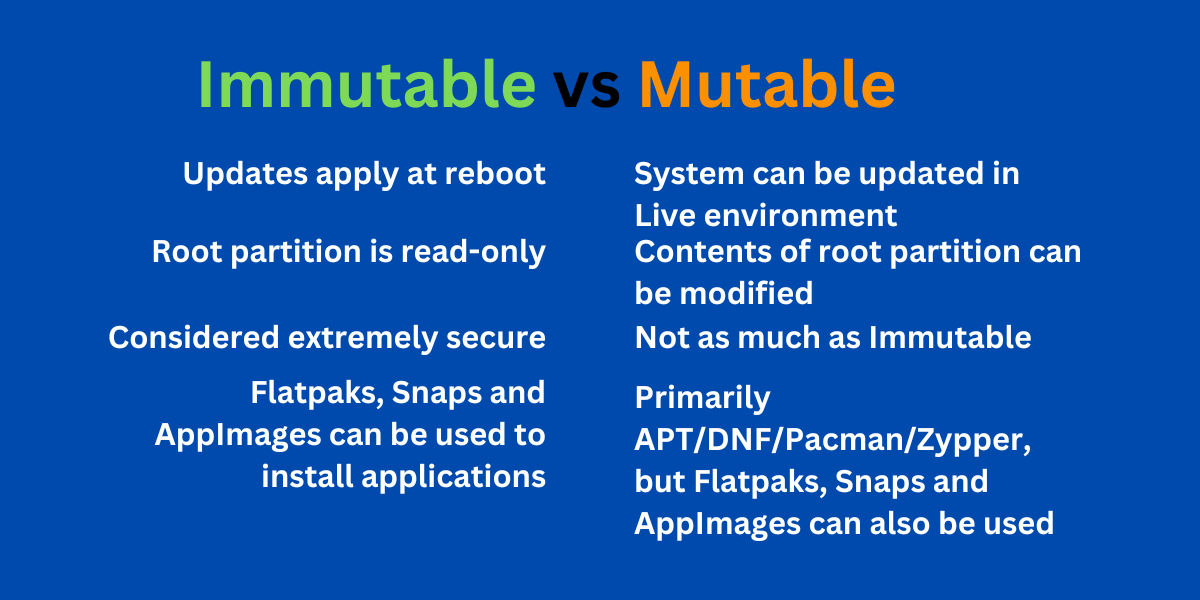I used an immutable fedora on my surface pro 4, I wanted to shoot myself in the face every time I had to install anything. I'm good on that for the rest of my natural life.
Linux
From Wikipedia, the free encyclopedia
Linux is a family of open source Unix-like operating systems based on the Linux kernel, an operating system kernel first released on September 17, 1991 by Linus Torvalds. Linux is typically packaged in a Linux distribution (or distro for short).
Distributions include the Linux kernel and supporting system software and libraries, many of which are provided by the GNU Project. Many Linux distributions use the word "Linux" in their name, but the Free Software Foundation uses the name GNU/Linux to emphasize the importance of GNU software, causing some controversy.
Rules
- Posts must be relevant to operating systems running the Linux kernel. GNU/Linux or otherwise.
- No misinformation
- No NSFW content
- No hate speech, bigotry, etc
Related Communities
Community icon by Alpár-Etele Méder, licensed under CC BY 3.0
I'm much more comfortable trying things that I'm not sure will (or expect not to) work. I can just blast the toolbox or whatever afterwards.
Compare to some of my earlier forays into Linux, where I'd do some nonsense and then attempts to remove said nonsense would break some other load-bearing part of the OS.
I really appreciate rarely seeing the message "update complete, please reboot now". I would consider myself on the tech savvy side though.
I have investigated the idea and came to the conclusion that immutable distros are essentially a research project. They attempt to advance the state-of-art a slight bit but the cost is currently too great.
Perhaps somebody will some day create something that's worth switching to. But I don't think that has happened yet, or is happening with any of the current distros. Silverblue might become that with enough polish, but I feel that to get that amount of polish, they would have to make Silverblue the 1st class citizen, i.e. the default install of Fedora.
I switched to silver blue after a bad update and my experience has been almost identical if not smoother than standard fedora
what does the community think of it?
Everyone has their own opinion, personally I think they're a great idea and have lots of great applications. But just like rolling vs non-rolling release it's a personal and application dependant choice.
Do the downsides outweigh the benefits or vice versa?
Again, depends, for my personal computer I wouldn't use it because I think it could get complicated to get specific things to work, but for closed hardware like the Deck or even a fairly stable desktop used as a gaming system it's perfect.
Could this help Linux reach more mainstream audiences?
It could, it can also hamper it because people might start to try solutions that only work until next boot and not understanding why, or having problems getting some special hardware to work (more than it would be a mutable distro). But there is a great counter to this which is that once it's running it will be very difficult to break by user error.
At the end of the day I think it's a cool technology but that people should know what they're getting into, just like when choosing rolling vs non-rolling distro, it's not about what's better, but what suits your needs best.
Since the idea is that the "root partition" is immutable, serious question:
How do you fix a hardware config issue or a distro packaging / provision issue in an immutable distro?
Several times in my Linux history I've found that, for example, I need to remove package-provided files from the ALSA files in /usr/share/alsa in order for the setup to work with my particular chipset (which has a hardware bug). Other times, I've found that even if I set up a custom .XCompose file in my $HOME, some applications insist on reading the Compose files in /usr/share/X11/locale instead, which means I need to be able to edit or remove those files. In order to add custom themes, I need to be able to add them to /usr/share/{icons,themes}, since replicating those themes for each $HOME in the system is a notorious waste of space and not all applications seem to respect /usr/local/share. Etc.
Unless I'm mistaken on how immutable systems work, I'm not sure immutable systems are really useful to someone who actually wants to or needs to power user Linux, or customize past the "branding locking" that environments like Gnome have been aiming for for like a decade.
